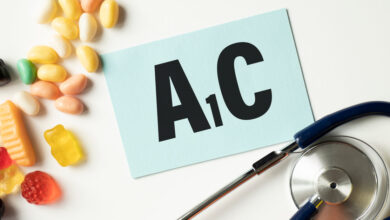What is the Importance of Alcohol Control in Diabetes?

It is important to understand alcohol control in diabetes. While moderate amounts of alcohol may cause blood sugar to rise, excess alcohol can actually decrease your blood sugar levels. Sometimes, alcohol can even cause it to drop to hypoglycaemic levels, especially for people with type 1 diabetes.
The Effects of Consuming Excess Alcohol
- Beer and sweet wine contain carbohydrates and may raise blood sugar.
- Alcohol stimulates your appetite, which can cause you to overeat and may affect your blood sugar control.
- Alcoholic drinks often have a lot of calories, making it more difficult to lose excess weight.
- Alcohol may also affect your judgment or willpower, causing you to make poor food choices.
- Alcohol can interfere with the positive effects of oral diabetes medicines or insulin.
- Alcohol may increase triglyceride levels.
- Alcohol may increase blood pressure.
- Alcohol can cause flushing, nausea, increased heart rate, and slurred speech. These may be confused with or mask the symptoms of low blood sugar.
How much can we drink without being excessive? We tend to use standard drinks as a guide. What is a “standard drink”? In Australia, a standard drink is any drink containing 10 grams of alcohol, regardless of container size or alcohol type (e.g. beer, wine, spirit).
- 285 mL of full-strength beer (4.8% alc. vol).
- 375mL of mid-strength beer (3.5% alc. vol).
- 425 mL of low-strength beer (2.7% alc. vol).
- 100 mL of wine (red – 13% alc. vol, and white – 11.5% alc. vol).
- 100 mL of champagne (12% alc. vol).
- 30 mL of spirits (40% alc. vol).
- 275 mL bottle of ready-to-drink beverage (5% alcohol content).
The Recommended Healthy Intake of Alcohol
Australian food labeling laws require all packaged alcohol to include the number of standard drinks on its label. Counting your standard drinks can help you stay within the National Healthy and Medical Research Council (NHMRC) Guidelines:
- For healthy men and women, drinking no more than two standard drinks on any day reduces the lifetime risk of harm from alcohol-related disease or injury.
- For healthy men and women, drinking no more than four standard drinks on a single occasion reduces the risk of alcohol-related injury arising from that occasion.
- Two alcohol free days a week reduces your risk of alcohol related organ damage.
How Alcohol Adversely Effects your Blood Glucose Levels
Alcohol can cause delayed hypoglycaemia by blocking glucose production in the liver. Impairment of the senses by a combination of alcohol and hypoglycaemia can be very dangerous. I advise my patients with diabetes to be more diligent with their blood glucose testing when they drink alcohol.
Blood glucose levels should be checked regularly, especially before going to bed and overnight if concerned. If you are using insulin, a reduction in evening insulin may be needed to avoid overnight ‘hypos’ after drinking.
Become more aware of how alcohol control in diabetes affects your BGL. Test more often when you drink and then discuss the results with your doctor and diabetes educator. It may be wise to have a person wake you the next morning at an appropriate time to ensure that you are feeling well and that you have not had a hypoglycaemic event overnight.
Apart from the immediate and short-term effects of alcohol, we must also consider the long-term effects. Alcohol has empty calories, meaning it has no nutritional value. As such, we run the risk of weight gain when we drink in excess of what our body can handle. In turn, the extra weight can impact on our diabetes control.
Further, the effects of alcohol on the liver are well known: fatty liver infiltration, damage and cirrhosis are all terms you will have heard about with regards to alcohol and the liver.
People with diabetes are already at risk of developing fatty liver. Specifically, they are at risk of developing a condition called non-alcoholic fatty liver disease (NAFLD) and non-alcoholic steatohepatitis (NASH). Given this predisposition to liver damage, you can see that drinking in excess of healthy quantities is not conducive to well controlled diabetes.
Who Can Help Manage your Alcohol Intake?
Your GP, diabetes educator and psychologist can help support your alcohol control in diabetes. It’s important to understand which diabetes team members you need on your team.
Conclusion: Understanding Alcohol Control in Diabetes
- Alcohol stimulates your appetite, which can cause you to overeat and may affect your blood sugar control.
- Alcohol can interfere with the positive effects of oral diabetes medicines or insulin.
- Alcohol may increase triglyceride levels.
- Alcohol may increase blood pressure.
- Alcohol can cause delayed hypoglycaemia by blocking glucose production in the liver. Impairment of the senses by a combination of alcohol and hypoglycaemia can be very dangerous.
- Be more diligent with blood glucose testing when you drink alcohol. Blood glucose levels should be checked regularly, especially before going to bed and overnight if concerned. If you are using insulin, a reduction in evening insulin may be needed to avoid overnight ‘hypos’ after drinking.
- For healthy men and women, drinking no more than two standard drinks on any day reduces the lifetime risk of harm from alcohol-related disease or injury.
- Two alcohol free days a week reduces your risk of alcohol related organ damage.



